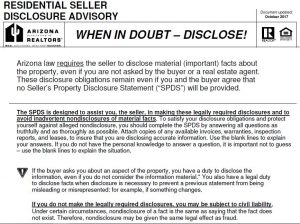 What is SPDS?
What is SPDS?
Sellers in Arizona are obligated, by law, to disclose all known material facts about the property to buyer. The Arizona Buyer Advisory informs seller that if buyer asks about a specific aspect of the property, seller has a duty to disclose the information, regardless of whether they believe it to be material. If something about the property changes after delivery of Seller Property Disclosure Statement (SPDS) to buyer, it must be disclosed and seller also has a legal duty to prevent a statement from being misleading or misrepresented.
Disclosure is best provided by using the Arizona SPDS. The Arizona purchase contract obligates the seller to provide the SPDS to the buyer within 3 days after contract acceptance and obligates seller to provide buyer with a written 5-year insurance claims history from seller’s insurance company regarding the premises (or a claims history for length of time seller has owned the premises, if less than 5 years).
Even if seller has never lived at property, it is important they complete all information they have knowledge of.
The general rule of thumb regarding whether or not to disclose something is “when in doubt, disclose.” There are very specific cases when disclosure is not required. Material facts that do not need to be disclosed are very limited and sellers are protected by stigmatized property law in these few circumstances.
What is “material” has been openly defined and is subjective. It is prudent to act on the philosophy that everything should be disclosed, unless it is considered confidential information. Most questions on the Arizona SPDS start by asking seller “Are you aware of…” so if seller answers “No” to the question if they are aware of any past or present roof leaks, seller is not saying there are no roof leaks, they are saying they are not aware of any roof leaks.
Even with SPDS, sellers may fail to disclose an issue because they believe it was inconsequential or it has been repaired. Just because an issue has been repaired does not mean it does not need to be disclosed. On the contrary, seller is doing themselves a disservice by not completely disclosing any repairs made and indicating what problem called for repair. By providing that disclosure, seller is protecting themselves from possible litigation.
Sometimes sellers fail to disclose something because they don’t want to disclose it out of fear they may jeopardize a sale. In Arizona, a common disclosure topic is the presence of scorpions. On the SPDS, there are specific questions regarding scorpions and other desert creatures. If seller neglects to mention presence of scorpions (if in fact scorpions have been present at property) and buyer subsequently discovers scorpions, talks to neighbors after closing and learns seller had discussed with neighbors how to get rid of scorpions, there would likely be liability to seller.
Certain properties require more specialized disclosures, notably those:
– near public or military airports
– with septic systems or alternative waste water treatment facilities
– using a domestic water well
– built prior to 1978
The Arizona purchase contract requires a Swimming Pool Barrier Disclosure to be included along with buyer’s requirement to initial this disclosure acknowledging they are aware of it.
The HOA Addendum requires disclosure of the existence of any homeowners association, amount of dues and transfer fees if any, and calls for detailed information to be provided to buyer regarding HOA.
If property is located in an un-subdivided, unincorporated area (such as in a county island), seller must provide an Affidavit of Disclosure which details specific attributes about property, including legal and physical access, who maintains roads, how water is provided and other important issues. This disclosure must be made at least seven days prior to close of escrow. The buyer then has the right to rescind or cancel the transaction for a period of five days after receipt of affidavit of disclosure. This affidavit must also be notarized and recorded with the deed.
What information is contained in the Arizona Seller’s Property Disclosure Statement?
The SPDS starts with Ownership and Property Information, which includes information on owner/occupancy, rental information, existing liens or assessments, pending litigation regarding the property or HOA if any, title issues, access, road maintenance, zoning, violations and homeowner’s insurance claims.
Building and Safety Information calls for disclosure regarding the structure, damage to property by natural causes, wood infestation, heating and cooling, plumbing, swimming pool/spa/hot tub/sauna/water feature, electrical and mechanical systems, plus information including presence of scorpions, rabid animals, bee swarms, rodents, owls, reptiles or other wild life. It also addresses whether additional construction has been done to the property and whether permits were required and obtained.
Utilities Information asks what services property receives, who provides these services, and covers details regarding water source (city, private, well or hauled), mail delivery and solar systems if any.
Environmental Information covers soil issues, external factors such as airport noise, traffic noise, neighborhood noise and nuisances, plus drug lab and superfund area disclosure, flood plain, water leaks on property and presence of mold if any.
Sewer/Wastewater Treatment addresses questions relating to sewer connection or on-site waste water treatment (septic system) facility if any.
The final section provides seller with an opportunity to disclose anything else that may be material to buyer and to provide additional explanations.
